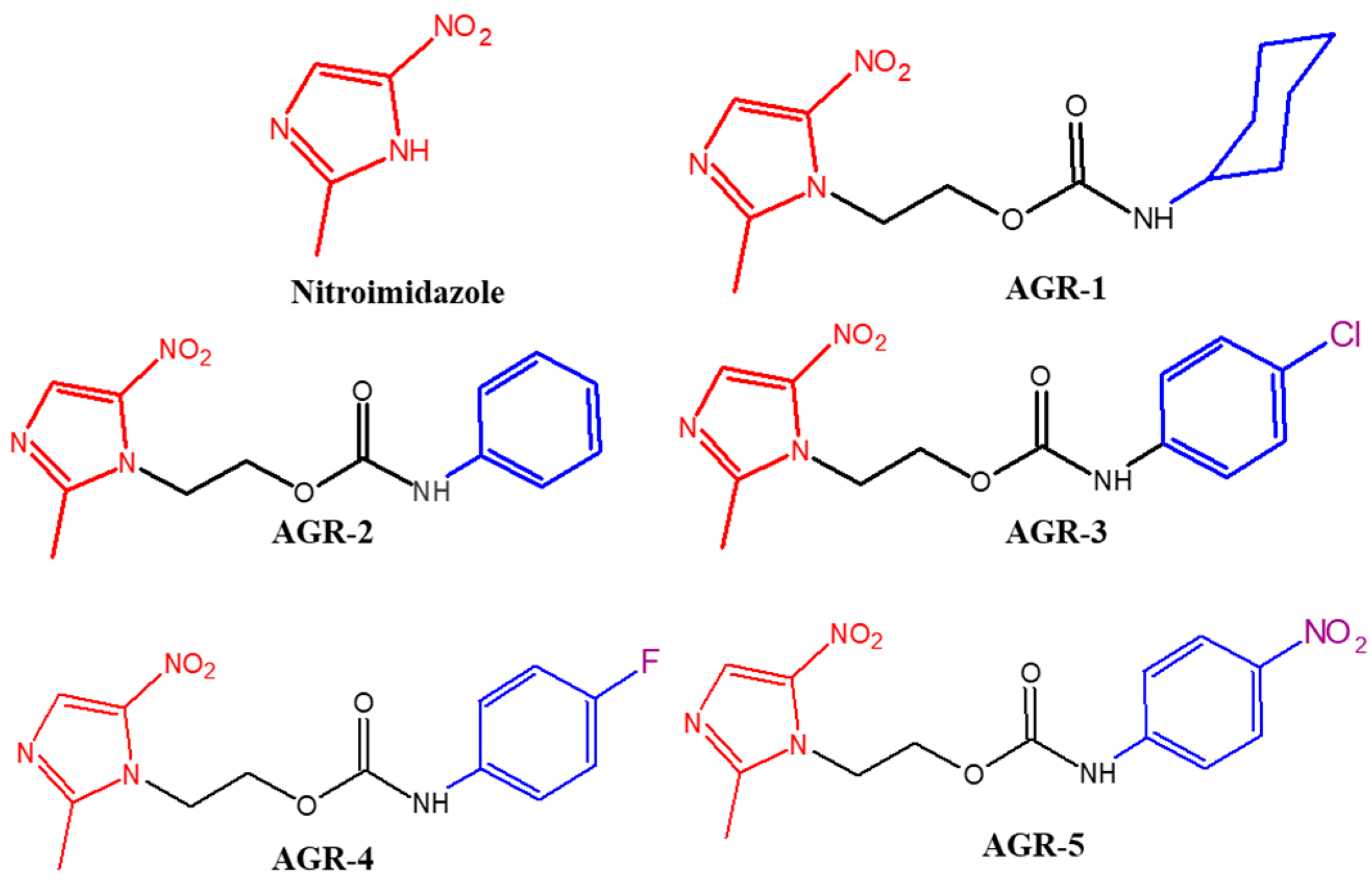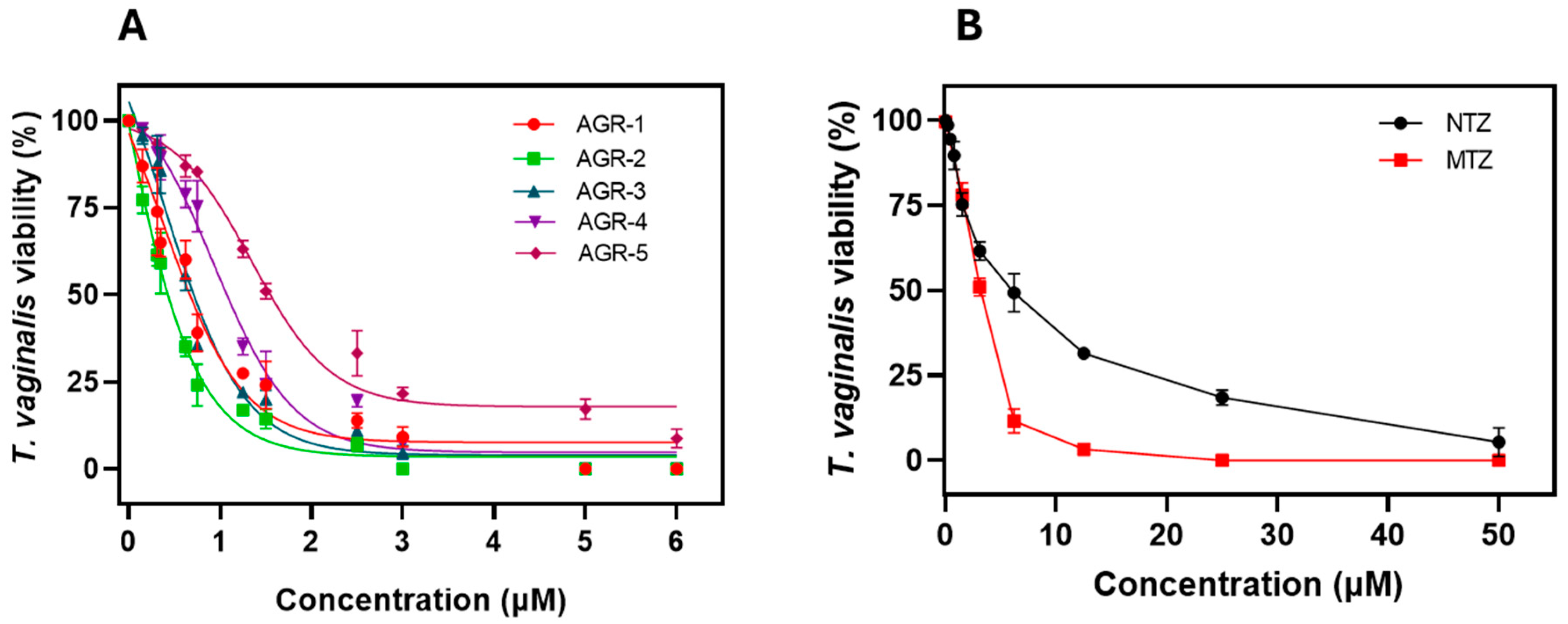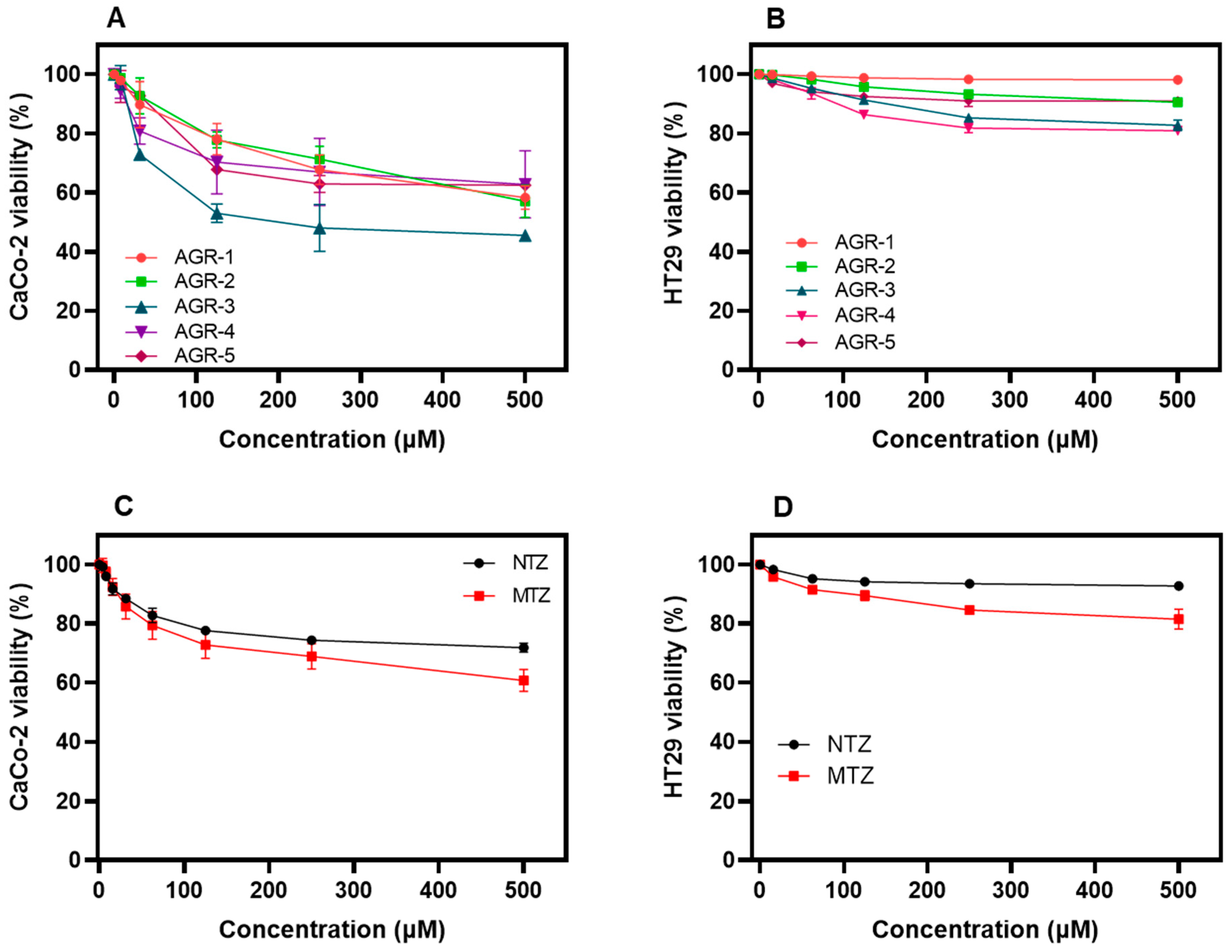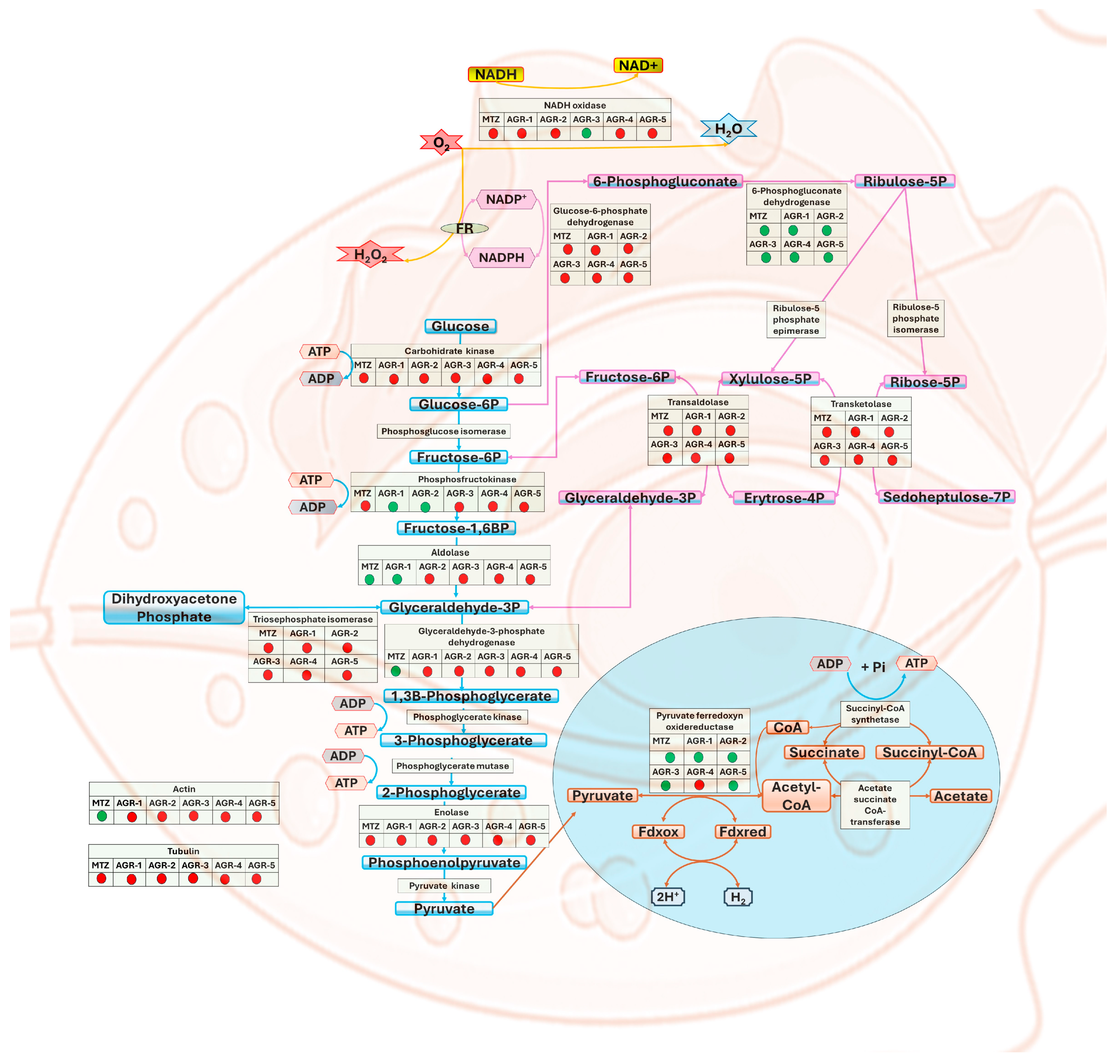Imidazole Carbamates as a Promising Alternative for Treating Trichomoniasis: In Vitro Effects on the Growth and Gene Expression of Trichomonas vaginalis
Abstract
:1. Introduction
2. Results and Discussion
2.1. Selection of Compounds That Inhibit the Viability of Trichomonas vaginalis
2.2. Determination of IC50 Values
2.3. Evaluation of the Cytotoxicity of the AGR Compounds
2.4. Predicted Pharmacokinetic Values of AGR Compounds
2.5. Determination of the Expression Levels of Genes Involved in the Metabolism of Trichomonas vaginalis
2.6. Limitations
3. Materials and Methods
3.1. Parasites and Cell Culture
3.2. Selection of Compounds That Inhibit the Viability of Trichomonas vaginalis
3.3. Determination of IC50 Values
3.4. Effect of the Compounds on the Kinetic Growth Curve of Trichomonas vaginalis
3.5. In Vitro Cytotoxicity Assay
3.6. Primer Design
3.7. RNA Extraction and Synthesis of First-Strand cDNA
3.8. Analysis of the Relative Gene Expression of T. vaginalis in the Presence of the Compounds
4. Conclusions
Author Contributions
Funding
Institutional Review Board Statement
Informed Consent Statement
Data Availability Statement
Acknowledgments
Conflicts of Interest
References
- Aquino, M.F.K.; Hinderfeld, A.S.; Simoes-Barbosa, A. Trichomonas vaginalis. Trends Parasitol. 2020, 36, 646–647. [Google Scholar] [CrossRef]
- Kissinger, P. Trichomonas vaginalis: A review of epidemiologic, clinical and treatment issues. BMC Infect. Dis. 2015, 15, 307. [Google Scholar] [CrossRef]
- World Health Organization. Global Incidence and Prevalence of Selected Sexually Transmitted Infections-2008; World Health Organization: Geneva, Switzerland, 2012. [Google Scholar]
- Van Gerwen, O.T.; Muzny, C.A. Recent advances in the epidemiology, diagnosis, and management of Trichomonas vaginalis infection. F1000Research 2019, 8, 1666. [Google Scholar] [CrossRef]
- Leitsch, D. Recent advances in the Trichomonas vaginalis field. F1000Research 2016, 5, 162. [Google Scholar] [CrossRef]
- Bouchemal, K.; Bories, C.; Loiseau, P.M. Strategies for prevention and treatment of Trichomonas vaginalis infections. Clin. Microbiol. Rev. 2017, 30, 811–825. [Google Scholar] [CrossRef]
- Allsworth, J.E.; Ratner, J.A.; Peipert, J.F. Trichomoniasis and other sexually transmitted infections: Results from the 2001–2004 National Health and Nutrition Examination Surveys. Sex. Transm. Dis. 2009, 36, 738–744. [Google Scholar] [CrossRef]
- Upcroft, J.A.; Dunn, L.A.; Wright, J.M.; Benakli, K.; Upcroft, P.; Vanelle, P. 5-Nitroimidazole drugs effective against metronidazole-resistant Trichomonas vaginalis and Giardia duodenalis. Antimicrob. Agents. Chemother. 2006, 50, 344−347. [Google Scholar] [CrossRef]
- Sørensen, C.G.; Karlsson, W.K.; Amin, F.M.; Lindelof, M. Metronidazole-induced encephalopathy: A systematic review. J. Neurol. 2020, 267, 1–13. [Google Scholar] [CrossRef]
- Dunne, R.L.; Dunn, L.A.; Upcroft, P.; O’Donoghue, P.J.; Upcroft, J.A. Drug resistance in the sexually transmitted protozoan Trichomonas vaginalis. Cell Res. 2003, 13, 239–249. [Google Scholar] [CrossRef]
- Conrad, M.D.; Gorman, A.W.; Schillinger, J.A.; Fiori, P.L.; Arroyo, R.; Malla, N.; Dubey, M.L.; Gonzalez, J.; Blank, S.; Secor, W.E.; et al. Extensive genetic diversity, unique population structure and evidence of genetic exchange in the sexually transmitted parasite Trichomonas vaginalis. PLoS Negl. Trop. Dis. 2012, 6, e1573. [Google Scholar] [CrossRef]
- Workowski, K.A.; Bachmann, L.H.; Chan, P.A.; Johnston, C.M.; Muzny, C.A.; Park, I.; Reno, H.; Zenilman, J.M.; Bolan, G.A. Sexually Transmitted Infections Treatment Guidelines, 2021. MMWR Recomm. Rep. 2021, 70, 1–187. [Google Scholar] [CrossRef]
- Schmid, G.; Narcisi, E.; Mosure, D.; Secor, W.E.; Higgins, J.; Moreno, H. Prevalence of metronidazole-resistant Trichomonas vaginalis in a gynecology clinic. Int. J. Reprod. Med. 2001, 46, 545–549. [Google Scholar] [CrossRef]
- Kirkcaldy, R.D.; Augostini, P.; Asbel, L.E.; Bernstein, K.T.; Kerani, R.P.; Mettenbrink, C.J.; Pathela, P.; Schwebke, J.R.; Secor, W.E.; Workowski, K.A.; et al. Trichomonas vaginalis antimicrobial drug resistance in 6 US cities, STD Surveillance Network, 2009–2010. Emerg. Infect. Dis. 2012, 18, 939–943. [Google Scholar] [CrossRef]
- Kulda, J. Trichomonads, hydrogenosomes and drug resistance. Int. J. Parasitol. 1999, 29, 199–212. [Google Scholar] [CrossRef]
- Tachezy, J.; Kulda, J.; Tomkova, E. Aerobic resistance of Trichomonas vaginalis to metronidazole induced in vitro. Parasitology 1993, 106, 31–37. [Google Scholar] [CrossRef]
- Leitsch, D.; Janssen, B.D.; Kolarich, D.; Johnson, P.J.; Duchene, M. Trichomonas vaginalis flavin reductase 1 and its role in metronidazole resistance. Mol. Microbiol. 2014, 91, 198–208. [Google Scholar] [CrossRef]
- Leitsch, D.; Drinic, M.; Kolarich, D.; Duchene, M. Down-regulation of flavin reductase and alcohol dehydrogenase-1 (ADH1) in metronidazole-resistant isolates of Trichomonas vaginalis. Mol. Biochem. Parasitol. 2012, 183, 177–183. [Google Scholar] [CrossRef]
- Hrdý, I.; Cammack, R.; Stopka, P.; Kulda, J.; Tachezy, J. Alternative pathway of metronidazole activation in Trichomonas vaginalis hydrogenosomes. Antimicrob. Agents Chemother. 2005, 49, 5033–5036. [Google Scholar] [CrossRef]
- Cerkasovova, A.; Novak, J.; Cerkasov, J.; Kulda, J.; Tachezy, J. Metabolic properties of Trichomonas vaginalis resistant to metronidazole under anaerobic conditions. Acta Univ. Carol. Biol. 1988, 30, 505–512. [Google Scholar]
- Rocha-Garduno, G.; Hernandez-Martinez, N.A.; Colin-Lozano, B.; Estrada-Soto, S.; Hernandez-Nunez, E.; Prieto-Martinez, F.D.; Medina-Franco, J.L.; Chale-Dzul, J.B.; Moo-Puc, R.; Navarrete-Vazquez, G. Metronidazole and Secnidazole Carbamates: Synthesis, Antiprotozoal Activity, and Molecular Dynamics Studies. Molecules 2020, 25, 793. [Google Scholar] [CrossRef]
- Trussell, R.E.; Johnson, G. Physiology of pure culture of Trichomonas vaginalis: III. Fermentation of carbohydrates and related compounds. Proc. Soc. Exp. Biol. Med. 1941, 47, 176–178. [Google Scholar] [CrossRef]
- Müller, M.; Mentel, M.; van Hellemond, J.J.; Henze, K.; Woehle, C.; Gould, S.B.; Yu, R.Y.; van der Giezen, M.; Tielens, A.G.; Martin, W.F. Biochemistry and evolution of anaerobic energy metabolism in eukaryotes. Microbiol. Mol. Biol. Rev. 2012, 76, 444–495. [Google Scholar] [CrossRef] [PubMed]
- Doan, T.H.; Yen-Nicolaÿ, S.; Bernet-Camard, M.F.; Martin-Verstraete, I.; Péchiné, S. Impact of subinhibitory concentrations of metronidazole on proteome of Clostridioides difficile strains with different levels of susceptibility. PLoS ONE 2020, 15, e0241903. [Google Scholar] [CrossRef] [PubMed]
- Stover, N.A.; Dixon, T.A.; Cavalcanti, A.R. Multiple independent fusions of glucose-6-phosphate dehydrogenase with enzymes in the pentose phosphate pathway. PLoS ONE 2011, 6, e22269. [Google Scholar] [CrossRef] [PubMed]
- Morales-Luna, L.; Vázquez-Bautista, M.; Martínez-Rosas, V.; Rojas-Alarcón, M.A.; Ortega-Cuellar, D.; González-Valdez, A.; Pérez de la Cruz, V.; Arreguin-Espinosa, R.; Rodríguez-Bustamante, E.; Rodríguez-Flores, E.; et al. Fused Enzyme Glucose-6-Phosphate Dehydrogenase::6-Phosphogluconolactonase (G6PD::6PGL) as a Potential Drug Target in Giardia lamblia, Trichomonas vaginalis, and Plasmodium falciparum. Microorganisms 2024, 12, 112. [Google Scholar] [CrossRef] [PubMed]
- Allen, S.M.; Lim, E.E.; Jortzik, E.; Preuss, J.; Chua, H.H.; MacRae, J.I.; Rahlfs, S.; Haeussler, K.; Downton, M.T.; McConville, M.J.; et al. Plasmodium falciparum glucose-6-phosphate dehydrogenase 6-phosphogluconolactonase is a potential drug target. FEBS J. 2015, 282, 3808–3823. [Google Scholar] [CrossRef]
- Morales-Luna, L.; Hernández-Ochoa, B.; Martínez-Rosas, V.; Navarrete-Vázquez, G.; Ortega-Cuellar, D.; Rufino-González, Y.; González-Valdez, A.; Arreguin-Espinosa, R.; Franco-Vásquez, A.M.; de la Cruz, V.P.; et al. Giardia lamblia G6PD::6PGL Fused Protein Inhibitors Decrease Trophozoite Viability: A New Alternative against Giardiasis. Int. J. Mol. Sci. 2022, 23, 14358. [Google Scholar] [CrossRef] [PubMed]
- Martínez-Rosas, V.; Hernández-Ochoa, B.; Navarrete-Vázquez, G.; Martínez-Conde, C.; Gómez-Chávez, F.; Morales-Luna, L.; González-Valdez, A.; Arreguin-Espinosa, R.; Enríquez-Flores, S.; Pérez de la Cruz, V.; et al. Kinetic and Molecular Docking Studies to Determine the Effect of Inhibitors on the Activity and Structure of Fused G6PD::6PGL Protein from Trichomonas vaginalis. Molecules 2022, 27, 1174. [Google Scholar] [CrossRef]
- Mead, J.R.; Fernadez, M.; Romagnoli, P.A.; Secor, W.E. Use of Trichomonas vaginalis clinical isolates to evaluate correlation of gene expression and metronidazole resistance. J. Parasitol. 2006, 92, 196–199. [Google Scholar] [CrossRef]
- Wright, J.M.; Webb, R.I.; O’Donoghue, P.; Upcroft, P.; Upcroft, J.A. Hydrogenosomes of laboratory-induced metronidazole-resistant Trichomonas vaginalis lines are downsized while those from clinically metronidazole-resistant isolates are not. J. Eukaryot. Microbiol. 2010, 57, 171–176. [Google Scholar] [CrossRef]
- Wright, J.M.; Dunn, L.A.; Kazimierczuk, Z.; Burgess, A.G.; Krauer, K.G.; Upcroft, P.; Upcroft, J.A. Susceptibility in vitro of clinically metronidazole-resistant Trichomonas vaginalis to nitazoxanide, toyocamycin, and 2-fluoro-2′-deoxyadenosine. Parasitol. Res. 2010, 107, 847–853. [Google Scholar] [CrossRef] [PubMed]
- Hrdy, I.; Müller, M. Primary structure of the hydrogenosomal malic enzyme of Trichomonas vaginalis and its relationship to homologous enzymes. J. Eukaryot. Microbiol. 1995, 42, 593–603. [Google Scholar] [CrossRef] [PubMed]
- Müller, M. The hydrogenosome. J. Gen. Microbiol. 1993, 139, 2879–2889. [Google Scholar] [CrossRef] [PubMed]
- Hrdy, I.; Tachezy, J.; Muller, M. Metabolism of trichomonad hydrogenosomes. In Hydrogenosomes and Mitosomes: Mitochondria of Anaerobic Eukaryotes; Tachezy, J., Ed.; Springer: Berlin/Heidelberg, Germany, 2008; pp. 114–145. [Google Scholar]
- Chabrière, E.; Charon, M.H.; Volbeda, A.; Pieulle, L.; Hatchikian, E.C.; Fontecilla-Camps, J.C. Crystal structures of the key anaerobic enzyme pyruvate:ferredoxin oxidoreductase, free and in complex with pyruvate. Nat Struct Biol. 1999, 6, 182–190. [Google Scholar]
- Duwor, S.; Brites, D.; Mäser, P. Phylogenetic Analysis of Pyruvate-Ferredoxin Oxidoreductase, a Redox Enzyme Involved in the Pharmacological Activation of Nitro-Based Prodrugs in Bacteria and Protozoa. Biology 2024, 13, 178. [Google Scholar] [CrossRef] [PubMed]
- Müller, M. Biochemical cytology of trichomonad flagellates. I. Subcellular localization of hydrolases, dehydrogenases, and catalase in Tritrichomonas foetus. J. Cell Biol. 1973, 57, 453–474. [Google Scholar]
- Lamien-Meda, A.; Leitsch, D. Identification of the NADH-oxidase gene in Trichomonas vaginalis. Parasitol. Res. 2020, 119, 683–686. [Google Scholar] [CrossRef]
- Kusdian, G.; Woehle, C.; Martin, W.F.; Gould, S.B. The actin-based machinery of Trichomonas vaginalis mediates flagellate-amoeboid transition and migration across host tissue. Cell. Microbiol. 2013, 15, 1707–1721. [Google Scholar] [CrossRef] [PubMed]
- Lorenzo-Benito, S.; Rivera-Rivas, L.A.; Sánchez-Ayala, L.; Ortega-López, J.; Montes-Flores, O.; Talamás-Lara, D.; Arroyo, R. Omics Analyses of Trichomonas vaginalis Actin and Tubulin and Their Participation in Intercellular Interactions and Cytokinesis. Genes 2022, 13, 1067. [Google Scholar] [CrossRef]
- Diamond, L.S. The establishment of various trichomonads of animals and man in axenic cultures. J. Parasitol. 1957, 43, 488–490. [Google Scholar] [CrossRef]
- Hernández-Ochoa, B.; Martínez-Rosas, V.; Morales-Luna, L.; Calderón-Jaimes, E.; Rocha-Ramírez, L.M.; Ortega-Cuellar, D.; Rufino-González, Y.; González-Valdez, A.; Arreguin-Espinosa, R.; Enríquez-Flores, S.; et al. Pyridyl Methylsulfinyl Benzimidazole Derivatives as Promising Agents against Giardia lamblia and Trichomonas vaginalis. Molecules 2022, 27, 8902. [Google Scholar] [CrossRef]
- Nava-Zuazo, C.; Chávez-Silva, F.; Moo-Puc, R.; Chan-Bacab, M.J.; Ortega-Morales, B.O.; Moreno-Díaz, H.; Díaz-Coutiño, D.; Hernández-Núñez, E.; Navarrete-Vázquez, G. 2-Acylamino-5-nitro-1,3-thiazoles: Preparation and in vitro bioevaluation against four neglected protozoan parasites. Bioorg. Med. Chem. 2014, 22, 1626–1633. [Google Scholar] [CrossRef] [PubMed]
- Domínguez-Mendoza, E.A.; Galván-Ciprés, Y.; Martínez-Miranda, J.; Miranda-González, C.; Colín-Lozano, B.; Hernández-Núñez, E.; Hernández-Bolio, G.I.; Palomino-Hernández, O.; Navarrete-Vazquez, G. Design, Synthesis, and In Silico Multitarget Pharmacological Simulations of Acid Bioisosteres with a Validated In Vivo Antihyperglycemic Effect. Molecules 2021, 26, 799. [Google Scholar] [CrossRef] [PubMed]
- Alves, M.S.D.; Sena-Lopes, Â.; das Neves, R.N.; Casaril, A.M.; Domingues, M.; Birmann, P.T.; da Silva, E.T.; de Souza, M.V.N.; Savegnago, L.; Borsuk, S. In vitro and in silico trichomonacidal activity of 2,8-bis(trifluoromethyl) quinoline analogs against Trichomonas vaginalis. Parasitol. Res. 2022, 121, 2697–2711. [Google Scholar] [CrossRef] [PubMed]
- da Silva, C.C.; Pacheco, B.S.; das Neves, R.N.; Alves, M.S.D.; Sena-Lopes, A.; Moura, S.; Borsuk, S.; de Pereira, C.M.P. Antiparasitic activity of synthetic curcumin monocarbonyl analogues against Trichomonas vaginalis. Biomed. Pharmacother. 2019, 111, 367–377. [Google Scholar] [CrossRef]
- Gutiérrez-Cardona, J.Y.; Calderón-Jaimes, E.; Ortega-Cuellar, D.; Sánchez-Carrillo, A.; Castillo-Rodríguez, R.A.; Canseco-Ávila, L.M.; Rocha-Ramírez, L.M.; Martínez-Rosas, V.; Gómez-Manzo, S.; Hernández-Ochoa, B. Effect of Trichomonacide 6-Nitro-1H-benzimidazole Derivative Compounds on Expression Level of Metabolic Genes in Trichomonas vaginalis. Int. J. Mol. Sci. 2024, 25, 4568. [Google Scholar] [CrossRef]








| Compound | IC50 (µM) | CaCo-2 | HT29 | ||
|---|---|---|---|---|---|
| CC50 (µM) | SI | CC50 (µM) | SI | ||
| MTZ | 3.1 | 545 | 175 | 550 | 177 |
| NTZ | 6.62 | 580 | 87.6 | 634 | 95.7 |
| AGR-1 | 0.67 | 650 | 970.0 | 532 | 794 |
| AGR-2 | 0.40 | 560 | >1000 | 730 | >1000 |
| AGR-3 | 0.64 | 523 | 817.1 | 660 | >1000 |
| AGR-4 | 0.96 | 510 | 531.2 | 593 | 617 |
| AGR-5 | 1.45 | 580 | 400 | 560 | 386 |
| Model | Compounds | ||||||
|---|---|---|---|---|---|---|---|
| AGR-1 | AGR-2 | AGR-3 | AGR-4 | AGR-5 | MTZ | ||
| A | Gastrointestinal absorption | (+) High | (+) High | (+) High | (+) High | (+) High | (+) High |
| Caco-2 permeability | −4.67 | −4.5 | −4.46 | −4.59 | −4.66 | −4.71 | |
| Bioavailability (F) | <30% | <30% | <30% | <30% | <30% | <30% | |
| D | Plasma protein binding | 46% | 58% | 77% | 65% | 65% | 17% |
| BBB penetration | 0.82 | 0.664 | 0.795 | 0.62 | 0.29 | 0.83 | |
| Volume distribution | 0.809 L/kg | 0.831 L/kg | 0.859 L/kg | 0.878 L/kg | 0.84 L/kg | 0.83 L/kg | |
| M | CYP1A2 substrate | (−) No | (−) No | (+) Yes | (+) Yes | (−) No | (−) No |
| CYP2C19 substrate | (−) No | (+) Yes | (+) Yes | (+) Yes | (−) No | (+) Yes | |
| CYP2C9 substrate | (+) Yes | (−) No | (+) Yes | (+) Yes | (+) Yes | (+) Yes | |
| E | Clearance | 7.49 mL/min/kg | 9.47 mL/min/kg | 8.2 mL/min/kg | 9.44 mL/min/kg | 8.21 mL/min/kg | 6.29 mL/min/kg |
| Half-life (T½) | >3 h | >3 h | >3 h | >3 h | >3 h | >3 h | |
| T | hERG blockers | 0.21 | 0.22 | 0.47 | 0.37 | 0.68 | 0.04 |
| Rat oral acute toxicity | 0.31 | 0.22 | 0.23 | 0.33 | 0.14 | 0.038 | |
| Gene Symbol | Gene Name | Function | GenBank |
|---|---|---|---|
| CK | Carbohydrate kinase | Transferase in glycolysis | XM_001579622.1 |
| PFK | Phosphofructokinase | Transferase in glycolysis | XM_001581728.2 |
| ALDO | Aldolase | Oxidoreductase in glycolysis | XM_001315350.2 |
| TPI | Triose phosphate isomerase | Isomerase in glycolysis | XM_001320301.2 |
| GAPDH | Glyceraldehyde-3-phosphate dehydrogenase | Oxidoreductase in glycolysis | XM_001581066.2 |
| ENOL | Enolase | Hydratase in glycolysis | XM_001325471.2 |
| PK | Pyruvate kinase | Transferase in glycolysis | XM_001329865.2 |
| G6PD | Glucose-6-phosphate dehydrogenase | Oxidoreductase in pentose phosphate | XM_001321943.2 |
| 6PGDH | 6-phosphogluconate dehydrogenase | Oxidoreductase in pentose phosphate | XM_001323727.2 |
| TKT | Transketolase, | Transferase in pentose phosphate | XM_001326902.1 |
| TALDO | Transaldolase | Transferase in pentose phosphate | XM_001330311.2 |
| ACT | Actin | Cytoskeletal structural protein | XM_001301716.2 |
| TUB | Tubulin | Cytoskeletal structural protein | XM_001321203.2 |
| PFOR | Pyruvate-ferredoxin oxide reductase | Oxidoreductase enzyme | XM_001321286.2 |
| NADHOX | NADH oxidase | O2-Detoxifying enzyme | XM_001315387.2 |
| Gene | Sequence 5′ → 3′ | Amplicon (bp) | Tm (°C) |
|---|---|---|---|
| CK | Fw: 5′TACAACAGGAGCCGGAGATG 3′ Rv: 5′AGCAGCACAACCTCTCTTTG 3′ | 97 | 60 |
| PFK | Fw: 5′ TGCAGTTCTCTCTAGTGGCC 3′ Rv: 5′ CACGGAAGCCACCAGTAATG 3′ | 116 | 60 |
| ALDO | Fw: 5′ AAGTCACTCGGTCTCTGCAA 3′ Rv: 5′ TTGACGGAGGCTGTGATGAT 3′ | 125 | 60 |
| TPI | Fw: 5′ GGCAAGTGGGACGATGTTG 3′ Rv: 5′ TTAGCAGCAAGGATGTCACG 3′ | 122 | 60 |
| GAPDH | Fw: 5′ CCAAGTTGTCGCTATCCACG 3′ Rv: 5′ TGCTTAGCCTCATCGACTGT 3′ | 114 | 60 |
| ENOL | Fw: 5′ ACAGGTGTTGGTGAAGCTCT 3′ Rv: 5′ AGCACATTCCCTTGAGAGCT 3′ | 124 | 60 |
| PK | Fw: 5′ CCACAAGCAAACACTCGACA 3′ Rv: 5′ CTCCAACTTGCCAACACGAA 3′ | 109 | 60 |
| G6PD | Fw: 5′ ATTCTCACGTCTCCACCAGG 3′ Rv: 5′ GTCATCGTAGCCACCAGAGA 3′ | 109 | 60 |
| 6PGDH | Fw: 5′ CGATGGTGGCAACTCTCACT 3′ Rv: 5′ CTCTTCACCGCCGGAGATAC 3′ | 122 | 60 |
| TKT | Fw: 5′ GGAGTAAGACTTGGCTGGGA 3′ Rv: 5′ CGTTCTGCACATTTCTCTGGT 3′ | 125 | 60 |
| TALDO | Fw: 5′ TCCTCAAGATTGTCCCAGGC 3′ Rv: 5′ TCTTGATTCCGGCTTCGTGA 3′ | 123 | 60 |
| ACT | Fw: 5′ GTCAAGCTTCTCACAGAGCG 3′ Rv: 5′ GGCCTTCTCCATTTCAGCAT 3′ | 123 | 60 |
| TUB | Fw: 5′ CTTCCGTGGCCGTATGTCAT 3′ Rv: 5′ GCAGATAGCGGACTTGACGT 3′ | 115 | 60 |
| PFOR | Fw: 5′ CCAGATCACACCACTCGACT 3′ Rv: 5′ TTCCCAGTTCTTGCCCTCTT 3′ | 121 | 60 |
| NADHOX | Fw: 5′ ATTGGCTTGGCGTCCTTGAT 3′ Rv: 5′ TCGACGAGAACTGCACCTTC 3′ | 118 | 60 |
Disclaimer/Publisher’s Note: The statements, opinions and data contained in all publications are solely those of the individual author(s) and contributor(s) and not of MDPI and/or the editor(s). MDPI and/or the editor(s) disclaim responsibility for any injury to people or property resulting from any ideas, methods, instructions or products referred to in the content. |
© 2024 by the authors. Licensee MDPI, Basel, Switzerland. This article is an open access article distributed under the terms and conditions of the Creative Commons Attribution (CC BY) license (https://creativecommons.org/licenses/by/4.0/).
Share and Cite
Martínez-Rosas, V.; Navarrete-Vázquez, G.; Ortega-Cuellar, D.; Arreguin-Espinosa, R.; Pérez de la Cruz, V.; Calderón-Jaimes, E.; Enríquez-Flores, S.; Wong-Baeza, C.; Baeza-Ramírez, I.; Morales-Luna, L.; et al. Imidazole Carbamates as a Promising Alternative for Treating Trichomoniasis: In Vitro Effects on the Growth and Gene Expression of Trichomonas vaginalis. Molecules 2024, 29, 2585. https://doi.org/10.3390/molecules29112585
Martínez-Rosas V, Navarrete-Vázquez G, Ortega-Cuellar D, Arreguin-Espinosa R, Pérez de la Cruz V, Calderón-Jaimes E, Enríquez-Flores S, Wong-Baeza C, Baeza-Ramírez I, Morales-Luna L, et al. Imidazole Carbamates as a Promising Alternative for Treating Trichomoniasis: In Vitro Effects on the Growth and Gene Expression of Trichomonas vaginalis. Molecules. 2024; 29(11):2585. https://doi.org/10.3390/molecules29112585
Chicago/Turabian StyleMartínez-Rosas, Víctor, Gabriel Navarrete-Vázquez, Daniel Ortega-Cuellar, Roberto Arreguin-Espinosa, Verónica Pérez de la Cruz, Ernesto Calderón-Jaimes, Sergio Enríquez-Flores, Carlos Wong-Baeza, Isabel Baeza-Ramírez, Laura Morales-Luna, and et al. 2024. "Imidazole Carbamates as a Promising Alternative for Treating Trichomoniasis: In Vitro Effects on the Growth and Gene Expression of Trichomonas vaginalis" Molecules 29, no. 11: 2585. https://doi.org/10.3390/molecules29112585
APA StyleMartínez-Rosas, V., Navarrete-Vázquez, G., Ortega-Cuellar, D., Arreguin-Espinosa, R., Pérez de la Cruz, V., Calderón-Jaimes, E., Enríquez-Flores, S., Wong-Baeza, C., Baeza-Ramírez, I., Morales-Luna, L., Vázquez-Bautista, M., Rojas-Alarcón, M. A., Hernández-Ochoa, B., & Gómez-Manzo, S. (2024). Imidazole Carbamates as a Promising Alternative for Treating Trichomoniasis: In Vitro Effects on the Growth and Gene Expression of Trichomonas vaginalis. Molecules, 29(11), 2585. https://doi.org/10.3390/molecules29112585











